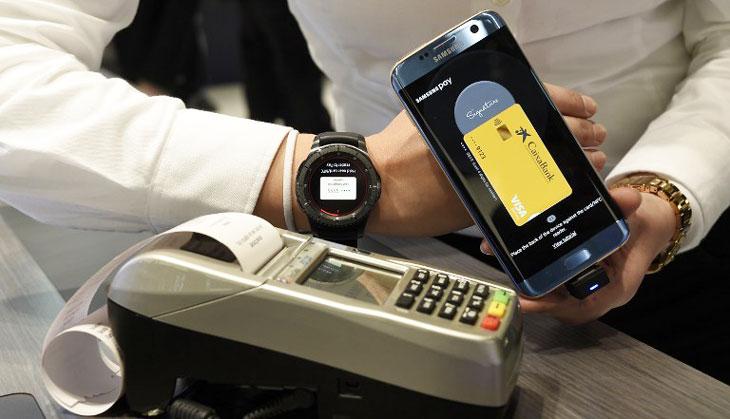Samsung Pay launches in India, but will it succeed?

First launched in South Korea in July 2015, Samsung have finally launched Samsung Pay in India. Pay. Samsung's secure mobile payment service, eliminates the need for physical wallets.
While select users had been granted early access to the application as early as two weeks ago, it is now publicly available on select Samsung devices - Galaxy S7 edge, Galaxy S7, Galaxy Note 5, Galaxy S6 edge+, Galaxy A5 (2015), Galaxy A7 (2016), Galaxy A5 (2017) and Galaxy A7 (2017). It even works with the Gear S3 smartwatch. Let's break it down:
What is Samsung Pay?
Samsung Pay is the company's flagship mobile payments service. "Simple and Secure" is the theme they are going with. Samsung Pay allows one to pay for goods and services by simply waving their Samsung smartphones over a point-of-sale (POS) machine. This replaces the need for debit and credit cards to make retail payments. Samsung Pay works with all the swipe-based machines that support Near Field Communication (NFC) and/or Magnetic Secure Transmission (MST).

How does it work?
NFC machines: NFC builds a high-frequency wireless network. This happens between the smartphone and payment terminal.
MST machines: MST sends magnetic waves from your Samsung smartphone to the payment terminal's card reader emulating a physical card. No upgrade - hardware or software - is needed from the payment terminals side.
Consumer: The user makes a payment by tapping/waving the smartphone on the POS machine, selecting the card for payment and authenticating using biometrics - the fingerprint of a four-digit PIN number.
Online: At the moment, Samsung Pay doesn't allow online payments. It can only be used for regular, in-person physical transactions.
Partners
At the launch, Samsung Pay will work with both debit cards and credit cards of a handful of banks - American Express, Axis Bank, HDFC Bank, ICICI Bank, State Bank of India (only credit cards) and Standard Chartered Bank. Citibank will be on board shortly. Visa and Mastercard are also launch partners.Through Axis Bank, Samsung Pay has provided a "mobile payment option built natively on the Unified Payment Interface (UPI), a payment system launched by the National Payments Corporation of India". This UPI solution facilitates peer-to-peer transfer of funds between two bank accounts on a mobile platform. At launch, only
Through Axis Bank, Samsung Pay has provided a "mobile payment option built natively on the Unified Payment Interface (UPI), a payment system launched by the National Payments Corporation of India". This UPI solution facilitates peer-to-peer transfer of funds between two bank accounts on a mobile platform. At launch, only Paytm is on board.
How secure is it?
Samsung says that Samsung Pay has three levels of security - fingerprint authentication, Card Tokenization and Samsung's very own security feature, Samsung Knox. Samsung, for its part, says that it doesn't store any card information. With Card Tokenization, a token number is stored as a placeholder.
Why launch Samsung Pay?
Samsung launched Samsung Pay because it allows a consumer to have everything in one device. Cards, mobile wallets, UPI, and more are all integrated into one easy-to-use application. It's simple, easy and secure. The idea behind the launch of Samsung Pay - besides simplifying transactions - is to attract customers toward the brand. Banks and credit providers are not charged yet for transactions and that means its easier to get them on board.
As of February, Samsung has a 25.1 percent market share, highest among all smartphone makers in India. In the 3rd quarter of 2016, its shipments crossed 30 million for the first time. There has never been a better time to launch Samsung Pay than now. Also the fact that Apple Pay and Android Pay are yet to launch is a huge bonus.
Samsung wants to stave off attention from its recent Galaxy Note 7 debacle and, with the incoming Galaxy S8, this could be a game-changer.
Samsung Pay vs Android Pay
The one advantage Samsung Pay has over Android Pay (that is yet to launch in India) is the fact that while both of them support NFC, Samsung Pay supports almost all POS machines courtesy of its decision to include MST support.
The one advantage Android Pay has over Samsung Pay is that it isn't limited to just high-end Samsung devices. Presumably, when Android Pay launches, it will be available on a plethora of Android devices and even some of those below 20k.
Limitations
The main limitations are Samsung's decision to launch Samsung Pay only on its phones costing 20k and above. It could have launched it across its portfolio of its phones but chose not to. Most of its consumers purchase phones under 20k. The company has left a great number of smartphones and users out of its reach. It also doesn't accept online payments and hence can't replace traditional mobile wallets as of yet.
Dead on arrival
While it may be an attractive feature to keep Samsung users within the ecosystem and buying the company's phones year after year, there is no incentive for the non-Samsung user to buy the brand's smartphones. The entry point is very high. A high-end flagship needs to have multiple features that set it apart. A phone that costs around 10k-15k just needs that one feature to differentiate it. With that, Samsung has largely ignored the majority of smartphone buyers most likely to buy into the brand.
Even though Samsung Pay is everywhere, Samsung phones aren't in the hands of the masses. That is the biggest downside. Reports are saying that 200 million 4G feature phones are to be sold in the next five years, this is the segment of people that will be the largest growth story for debit cards. If Samsung ignores that target group, the adoption of Samsung Pay may not be where the company wants it to be.
While any usage of Samsung Pay is good for the company in the short-term, it's the long-term growth that may plateau sooner rather than later. When Android Pay comes in - with its support of many more devices - Samsung Pay is going to find it hard to survive.
First published: 22 March 2017, 19:29 IST






![BJP's Kapil Mishra recreates Shankar Mahadevan’s ‘Breathless’ song to highlight Delhi pollution [WATCH] BJP's Kapil Mishra recreates Shankar Mahadevan’s ‘Breathless’ song to highlight Delhi pollution [WATCH]](https://images.catchnews.com/upload/2022/11/03/kapil-mishra_240884_300x172.png)

![Anupam Kher shares pictures of his toned body on 67th birthday [MUST SEE] Anupam Kher shares pictures of his toned body on 67th birthday [MUST SEE]](https://images.catchnews.com/upload/2022/03/07/Anupam_kher_231145_300x172.jpg)






